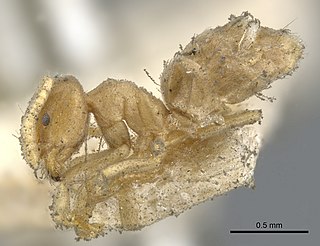
Dolichoderinae is a subfamily of ants, which includes species such as the Argentine ant, the erratic ant, the odorous house ant, and the cone ant. The subfamily presents a great diversity of species throughout the world, distributed in different biogeographic regions, from the Palearctic, Nearctic, Afrotropical region and Malaysia, to the Middle East, Australian, and Neotropical regions.
Meranoplus parviumgulatus is a species of ant in the genus Meranoplus. It is known from New Guinea and Papua New Guinea.

Pristomyrmex is a genus of ants in the subfamily Myrmicinae.

Chronoxenus is a genus of ants in the subfamily Dolichoderinae. The genus is known from Asia.
Bothriomyrmex anastasiae is a species of ant in the genus Bothriomyrmex. Described by Dubovikov in 2002, the species is endemic to the Russian Federation.

Bothriomyrmex atlantis is a species of ant in the genus Bothriomyrmex. Described by Forel in 1894, the species is endemic to Algeria.
Bothriomyrmex breviceps is a species of ant in the genus Bothriomyrmex. Described by Santschi in 1919, the species is endemic to Tunisia.
Bothriomyrmex crosi is a species of ant in the genus Bothriomyrmex. Described by Santschi in 1919, the species is endemic to Algeria.
Bothriomyrmex emarginatus is a species of ant in the genus Bothriomyrmex. Described by Santschi in 1911, the species is endemic to Tunisia.
Bothriomyrmex kusnezovi is a species of ant in the genus Bothriomyrmex. Described by Emery in 1925, the species is endemic to China, Kazakhstan and Kyrgyzstan.
Bothriomyrmex laticeps is a species of ant in the genus Bothriomyrmex. Described by Emery in 1925, the species is endemic to France.
Bothriomyrmex meridionalis is a species of ant in the genus Bothriomyrmex. Described by Roger in 1863, the species is widespread in various European countries and also in Africa, including Algeria, Bulgaria, Croatia, France, Georgia, Montenegro, Romania, Slovakia and Spain.

Bothriomyrmex paradoxus is a species of ant in the genus Bothriomyrmex. Described by Dubovikov and Longino in 2004, the species is endemic to Costa Rica and Honduras.
Bothriomyrmex pubens is a species of ant in the genus Bothriomyrmex. Described by Santschi in 1919, the species is endemic to Algeria and Tunisia.
Bothriomyrmex regicidus is a species of ant in the genus Bothriomyrmex. Described by Santschi in 1919, the species is endemic to Algeria and Tunisia.

Bothriomyrmex saundersi is a species of ant in the genus Bothriomyrmex. Described by Santschi in 1922, the species is endemic to Portugal and Spain.
Bothriomyrmex turcomenicus is a species of ant in the genus Bothriomyrmex. Described by Emery in 1925, the species is endemic to Kazakhstan, Turkey and Turkmenistan.
Bothriomyrmex urartus is a species of ant in the genus Bothriomyrmex. Described by Dubovikov in 2002, the species is endemic to Armenia.






